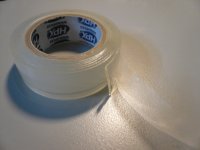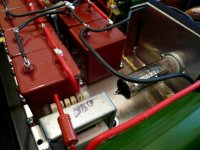Recently finished this push-pull amplifier. It is basically a Spud in push-pull, hence the Spud-Pull. Two 6E5P per channel, with a phase-inverting input transformer (Reinhofer) and a four-deck stepped attenuator. Both 6E5P share four Cree diodes at the cathode, about 30mA at 200 Volts per 6E5P. Power supply is EZ81 and diodes rectified with pi-filters using R and C. Very simple circuit with a bandwidth of 10 Hz up to 90 Khz (-1dB) with about 3.3 Watts into a 16 ohm load. Only remark is that this amplifier needs full line-out level for max power..
Oh, what a neat and minimalistic interior! Love it!
I'm glad you like it!
There is more than one way to skin a cat.
This is my version of a Dyna Stereo 70. The EL34's and transformers are similar, but that's about all. 6SN7 first and second stages, EL34 PP outputs. 0 - 14dB negative feedback only goes back to middle stage diff amp, so better phase margin. Front end is outside of loop. Front end has constant current sink instead of plate R, which drives a follower which has a current source in place of the cathode R. The follower drives the volume control, which then drives the 2nd stage, which is a diff amp, which has a current source in the tail. Switchable Ultra-linear 30W per channel, or Triode-mode 15W per channel. Each EL34 has a bias adjustment pot right next to it, and there's a digital meter that tells you the quiescent current in each tube. The photos are actually obsolete since I got rid of the grid cap front end tube, which picked up a little bit of hum, and replaced it with a 6SN7 - same tube spec wise but no grid cap. Now the hum is reduced to nothing noticeable. The current sink and sources increase linearity, but also power supply hum rejection. I call it, The Musicbox. The keyhole on the front is where you wind it up... (just kidding).
Nice build and unusual circuit. Must the sound be on pair with your efforts.
How did you wired the digital meter and which one is it? Very curious to know.
Hanging on wires heavy capacitors? Sure, minimalistic...
Not quite certain, if we are talking about the same construction. Capacitors are attached to wooden cover with plastic bands not wires, aren't they?
I guess the russian K75something caps were meant apparently dangling in free air (Magicbus's build).
But I see hot glue under them...😉
But I see hot glue under them...😉
No problem at all! And comments are welcome! I posted this in case anyone was interested. If you can find something similar, try it. It's really good!
This is the strongest adhesive I've ever hold in my hand! Double side.
Wow! What's it's name?
This is the strongest adhesive I've ever hold in my hand! Double side. Also the the K75-10 are soldered with one of their robust leads directly on the RCA!
Which HPX tape is that?
On occassions I use a doublesided tape used to fasten carpets to the floor. I guess it's much like Magicbus' tape which I believe is a bit "spongy", making it attach to not-so-flat surfaces better.
On occassions I use a doublesided tape used to fasten carpets to the floor. I guess it's much like Magicbus' tape which I believe is a bit "spongy", making it attach to not-so-flat surfaces better.
How long does it last in hot conditions? Can't find any data. I still use metal clamps when need to fix something. Probably, it is the result of my education, to design a military equipment... 😀
I have used the tape occassionally and it seems to "harden" by time. With hardening, I mean like epoxi resin. When disassembling amps, I had to use considerable force to get things apart.
Normally I prefer screws or ty-wraps to fix bigger componets like electrolytics.
Normally I prefer screws or ty-wraps to fix bigger componets like electrolytics.
The tape is only used occasionally where it's hard to use clamps and screws, and is allways compined with solid hardwiring that keeps everything in place. My oldest constuction using this method counts more than five years without any sign of loose. I don't know how it would perform under excessive heat but I avoid to apply it in the hottest points anyway.How long does it last in hot conditions? Can't find any data. I still use metal clamps when need to fix something. Probably, it is the result of my education, to design a military equipment... 😀
I also like building things like tanks, but it comes without saying that I can't compete the professionals! And I allways advise people to build better than I do...🙂
Attachments
I remember once I was building Poul Ladegaard's air bearing tonearm and needed to take the alu angle profiles apart after assembled with this tape. It took two heavy duty screwdrivers and my full strength!I have used the tape occassionally and it seems to "harden" by time. With hardening, I mean like epoxi resin. When disassembling amps, I had to use considerable force to get things apart.
Normally I prefer screws or ty-wraps to fix bigger componets like electrolytics.
- Home
- Amplifiers
- Tubes / Valves
- Photo Gallery

